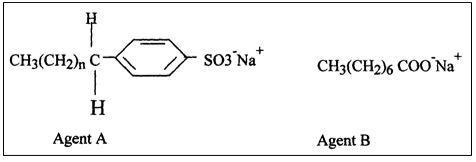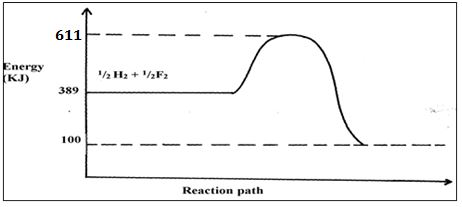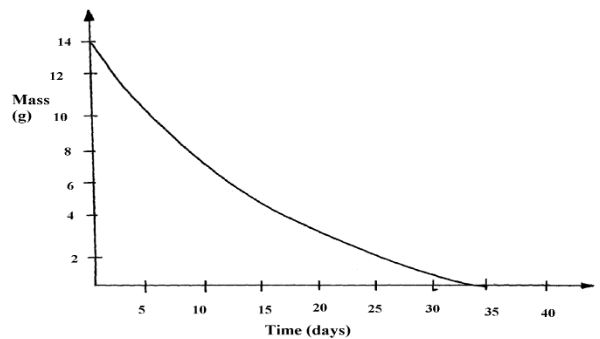Instruction to candidates
- KNEC mathematical tables and silent non- programmable electronic calculators may be used.
- All working must be clearly shown where necessary.
- Candidates should answer the questions in English.
-
- Complete the Table 1 below by naming the structure of the oxides of the elements.
(1 mark)Element Aluminium Silicon Sulphur Chlorine Structure of the oxide - One of the element forms an amphoteric oxide. Give the formula of the oxide. (1 mark)
- When excess sodium hydroxide is reacted with the oxide named above, a colourless complex ion is formed below.
[Al (OH)4]X
Explain how the value of X can be determined. (1 mark)
- Complete the Table 1 below by naming the structure of the oxides of the elements.
- The formulas in Figure 1 below represent active ingredients of two cleansing agents A and B.
Which one of the cleansing agents would be suitable to be used in water containing magnesium hydrogen carbonate. Explain your answer.
(2 marks) - An ion of element H has the formula:
1531 H3-- Give one use of the element in relation to organic chemistry. (1 mark)
- Using cross (x) and dots (.), draw the ion formation structure. (2 marks)
-
- Draw a well labelled set-up for the electrolysis of barium bromide. (2 marks)
- During an experiment of electrolysis of barium (ii) bromide, one of the electrode was not dipped in the electrolyte. Explain why the bulb did not light. (1 mark)
- Using chemical equations, show how bleaching action of sulphur (iv) oxide differ from the bleaching action of chlorine. (3 marks)
- Study the Table 2 below and answer the questions that follows.
Mineral acids Relative formula mass Boiling points HCl 36.5 35.0 HNO3 83 83.0 H2SO4 98 333.0 - Which of the following mineral acid is less volatile. (1 mark)
- Using chemical equations, explain how concentrated sulphuric (VI) acid displaces the more volatile mineral acids. (2 marks)
-
- Hydroxide ions are responsible alkalinity in a substance. An increase in the number of hydroxide ions influences two properties evident in a strong alkali.
State the two properties. (1 mark) - In an experiment, soap solution was added to two samples of water. The results below in Table 3 show the volume of soap solution required to lather with 500 cm3 of each water sample before and after boiling.
samples 1 2 Volume of soap used before water boiled 26.0 14.0 Volume of soap after water boiled 26.0 4.0 - Which water sample is likely to have permanent hardness? (1 mark)
- Explain the change in volume of soap solution used in sample 2. (1 mark)
- Hydroxide ions are responsible alkalinity in a substance. An increase in the number of hydroxide ions influences two properties evident in a strong alkali.
- 0.135 grams of a gaseous hydrocarbon X on complete combustion produces 0.41 grams of a gas found in beverages and 0.209 grams of a liquid that form largest part of the earth’s crust. 0.29 grams of X occupy 120 cm3 at room temperature and pressure. Name hydrocarbon X and draw its isomer. (4 marks)
-
- In an Experiment I, concentrated sulphuric (vi) acid was found to have no effect on litmus paper. In another Experiment II, dilute sulphuric (vi) acid was found to change blue litmus paper red. Explain the observations made. (1 mark)
- The diagram 1 below may be used to react dry hydrogen sulphide and dry sulphur (iv) oxide. Study it and answer the questions that follows.
- After sometime no observable change occurred. What would be done in order to see the observations? (1 mark)
- After the correction of the mistake done in b(i) above, state the possible observations made in the gas jars. (1 mark)
- Write the equation for the reaction. (1 mark)
-
- Explain how an increase in temperature affects solubility of salts. (1 mark)
- The Figure 2 below shows energy levels for the reaction;
½ H2 (g) + ½ F2 (g) → HF (g)
- Work out the activation energy, (Ea.) for the reaction. (1 mark)
- Calculate the heat of formation of HF. (1 mark)
- Is the reaction endothermic of exothermic? (1 mark)
- A typical electrolysis cell uses a current of 40, 000 amperes. Calculate the mass of aluminium (in Kg) produced in one hour.
(Al = 27.0, 1 Faraday = 96 500 coulombs) (3 marks) -
- Explain how hydrogen is used in the manufacture of margarine. (112 marks)
- For water gas(mixture of carbon (ii) oxide and hydrogen) to form, a suitable condition must be present.
- State the condition. (12 mark)
- Write the equation for the formation of water gas. (1 mark)
- Starting with sodium hydroxide, describe how you can obtain dry sodium hydrogen carbonate. (3 marks)
- 1.0 grams of an alloy of aluminium and copper were reacted with aqueous hydrochloric acid. If 840 cm3 of hydrogen at standard temperature and pressure was produced. Calculate the percentage of copper in the alloy.
(Al = 27.0, Molar Gas Volume = 22.4 dm3) (3 marks) - Carbon exists in many forms.
- Give the name of the impure form of carbon. (1 mark)
- Explain why the impure carbon identified above in (a), do not conduct electricity though it contains graphite with its structure. (1 marks)
- Charcoal is an example of an impure carbon. Give the property that makes it possible to be used in gas masks. (1 mark)
- Ethanol (C2H5OH) and dimethyl ether (C2H6O) has same relative molecular mass. However, dimethyl ether boils at – 24 while ethanol boils at 78.2. (2 marks)
- Study the information given in the table 4 below and answer the questions that follow.
Bond C-H Cl-Cl C-Cl H-Cl Average bond enthalpy(kJmol-1) 414 244 326 431 - Calculate the enthalpy change for the reaction. (2 marks)
CH4 (g) + Cl2 (g) CH3Cl(g) + HCl(g) - Is the reaction exothermic or endothermic? Explain your answer. (1 mark)
- Calculate the enthalpy change for the reaction. (2 marks)
-
- State the Avogadro’s law. (1 mark)
- 100 cm of hydrogen was mixed with 300cm3 of chlorine and the mixture allowed to react. Determine the maximum volume of hydrogen chloride gas that would form. (2 marks)
-
- What is a nuclide? (1 mark)
- The Figure 3 below shows the graph of a radioactive decay of a certain nuclide. Determine the half-life of the nuclide. (1 mark)
- What effect do excess exposures of radiation have on metals? (1 mark)
- A student mixed equal volume of Ethanol and butanoic acid. He added a few drops concentrated sulphuric (VI) acid and warmed the mixture.
- Name and write the formula of the main products. (2 marks)
Name………………………………………………………………………………………..
Formula…………………………………………………………………………………… - Which homologous series does the product named in (i) above belong?(1 mark)
- Name and write the formula of the main products. (2 marks)
- Study Figure 4 below and answer the question that follow.
- Name
- Solid V…………………………………… (1 mark)
- Gas W……………………………………(1 mark)
- Write an equation for reaction between solid V and dilute hydrochloric acid. (1 mark)
- Name
-
- A burning magnesium ribbon continues to burn in a jar of nitrogen gas but a burning splint is extinguished. Explain. (1 mark)
- Using equations explain what happens when concentrated nitric (V) acid is reacted with wood charcoal. (2 marks)
- The Figure 5 below represents a set of apparatus used to study properties of chlorine water.
- Name two components of chlorine water. (1 mark)
- Write an equation for the reaction that produces gas W. (1 mark)
- The following test was carried out on chlorine water contained in a test tube. A piece of blue flower was dropped in the test-tube. Explain why the flower was bleached. (2 marks)
- State and explain what would be observed if concentrated sulphuric (VI) acid is added to:
- Sugar crystals. (1 mark)
- Cobalt (ii) chloride crystals. (1 mark)
- 60 cm3 of ozone (O3) diffused through a semi permeable membrane in 80 seconds. Calculate the time taken for 90 cm3 of nitrogen (VI) oxide (NO2) to diffuse under the same conditions. (O = 16.0, N = 14) (3 marks)
- The table 5 below shows pH values of some solutions.
Solution A B C D 13 7 1 6.5 - What solution would react vigorously with sodium metal? (1 mark)
- Industrial hydrochloric acid. (1 mark)
- Which solution forms complex ions with zinc (II) oxide? (1 mark)
- 6g of Potassium nitrate solid was added to 120 cm3 of water in a plastic beaker. The mixture was stirred gently and the following results were obtained.
Initial temperature = 21.5 °C
Final temperature = 17.0 °C- Calculate the enthalpy change for the reaction. ( Density = 1g/cm3, C = 4.2 kJ kg-1K-1) (2marks)
- Calculate the molar enthalpy for the dissolution of potassium nitrate. (K = 39.0, N = 14.0, O = 16.0) (2 marks)
Join our whatsapp group for latest updates
Tap Here to Download for 50/-
Get on WhatsApp for 50/-
Download Chemistry Paper 1 Questions - Lanjet Joint Mock Exams 2023.
Tap Here to Download for 50/-
Get on WhatsApp for 50/-
Why download?
- ✔ To read offline at any time.
- ✔ To Print at your convenience
- ✔ Share Easily with Friends / Students






